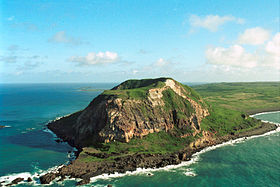Mount Suribachi
| Suribachi | |
|---|---|

Aerial view of Mount Suribachi, photographed in 2001
|
|
| Highest point | |
| Elevation | 169 m (554 ft) |
| Prominence | 169 metres (554 ft) |
| Coordinates | 24°45′01″N 141°17′20″E / 24.75028°N 141.28889°ECoordinates: 24°45′01″N 141°17′20″E / 24.75028°N 141.28889°E |
| Geography | |
| Parent range | Volcano Islands |
| Geology | |
| Mountain type | Cinder cone |
| Volcanic arc/belt | Volcano Islands |
| Last eruption | May 2, 2012 |
Mount Suribachi (JPN.: 摺鉢山, Suribachiyama) is a 169 m high mountain at the southwest end of the island Iwo Jima (now officially Iō-tō) in the northwest Pacific Ocean, under the administration of Ogasawara Subprefecture, Tokyo Metropolis, Japan.
The mountain's name derives from its shape, resembling a suribachi or "grinding bowl." It is also known as the "Mount Pipe" (JPN: パイプ山, paipu-yama), since the sulfur gas and water vapor that rolls in from the summit, alongside the rest of the island, give the appearance of a smoking pipe when viewed from the sea.
Joe Rosenthal's famous photograph Raising the Flag on Iwo Jima was taken at the mountain's peak.
Geologically, the mountain is a cinder cone of andesite, formed by volcanic activity. It is thought that the mountain is a dormant vent to a still active volcano (designated Iō-tō, the name of the island as a whole). From 1889 to 1957, the Japanese government recorded 16 eruptions on the peak. One eruption lasted for 65 minutes, and created a crater with a diameter of 35 meters and a depth of 15 meters on the runway near the former World War II airfield. Most recently, the Japanese Meteorological Agency reported that on May 2, 2012, a small eruption caused water discoloration to the northeast, and confirmed the appearance of a new fumarole.
During World War II, the Japanese built underground tunnel and bunker systems in and on Mount Suribachi. In February 1945, United States Marines invaded the island and initiated a major battle. For the United States, Iwo Jima was an important strategic point between the United States and mainland Japan, a status that resulted in severe fighting that took the lives of nearly 7,000 Americans and 20,000 Japanese.
...
Wikipedia

